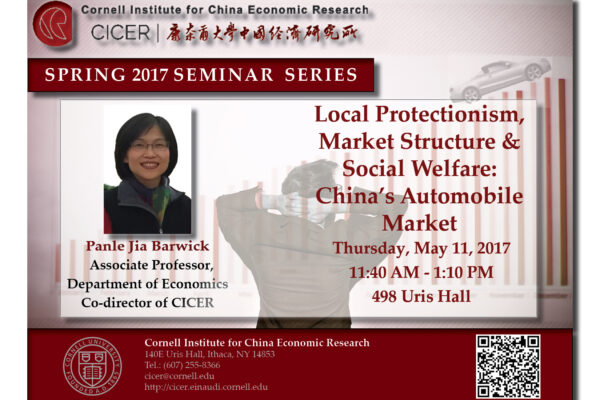Seminar: Local Protectionism, Market Structure, and Social Welfare: China’s Automobile Market


Panle Jia Barwick is an Associate Professor in the Economics Department at Cornell University and a faculty research associate at National Bureau of Economic Research. Her research interests are empirical industrial organization, applied econometrics, and Chinese economy. Her research has focused on three main topics: the effect of firm entry on market structure, the welfare consequences of market inefficiencies, and the application of new estimation techniques to empirical studies. Her research has appeared in the top five most prestigious economic journals including Econometrica and American Economic Review and has received the Zellner Award from the American Statistical Association. Professor Barwick is the inaugural recipient for Tufts Economics Alumni Achievement Award and the Advanced Young Scientist Award from University of Arizona.
She is a co-director of Cornell Institute for China Economic Research.
Abstract: While China has made great strides in transforming its centrally-planned economy to a market-oriented economy, there still exist widespread interregional trade barriers, such as policies and practices that protect local firms against competition from non-local firms. This study documents the presence of local protectionism and quantifies its impacts on market competition and social welfare in the context of China’s automobile market, the largest automobile market in the world. Using a census of vehicle registration records, we show that joint ventures (JVs) and especially state-owned enterprises (SOEs) command much higher market shares in their headquarter province than at the national level. Results from a spatial regression discontinuity analysis at provincial borders and falsification tests suggest that this pattern is not driven by differences in consumer preference or dealer network, and point to local protectionism such as subsidies of local brands as the primary contributing factor. We then set up and estimate a market equilibrium model to quantify the impact of local protectionism, controlling for other demand and supply factors. Our counterfactual simulations show that local protectionism leads to significant choice distortions and consumer welfare loss. It also benefits JVs and SOEs at the expense of more efficient private firms. In the long run, local protectionism could have important impacts on market structure such as firm entry and exit as well as resource allocation across regions.
Paper: http://einaudi.cornell.edu/sites/default/files/W4_PanleAndShanjun_Paper.pdf
Location: 498 Uris Hall
Sponsors:
- IO Seminar Series
- Public Economics
- Cornell Institute for China Economic Research (CICER)
